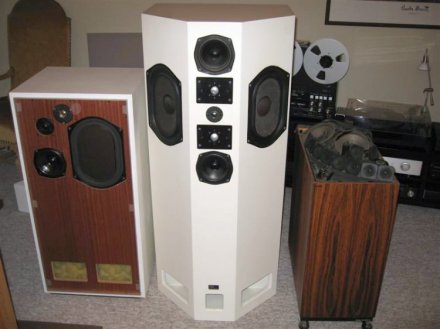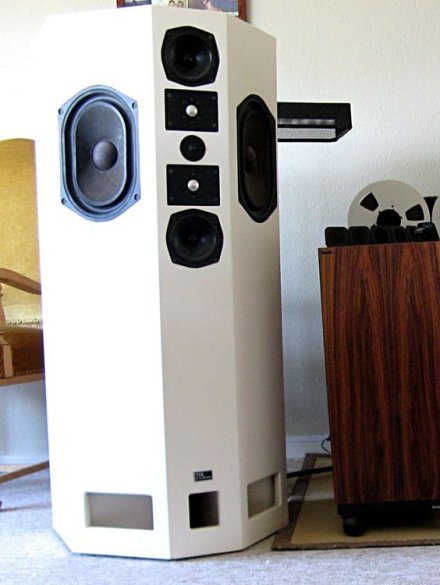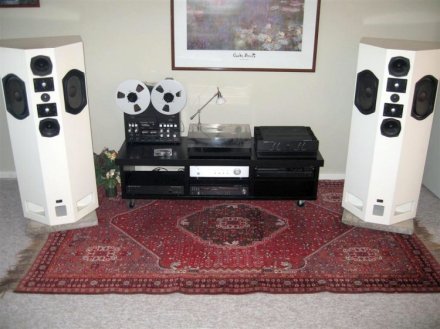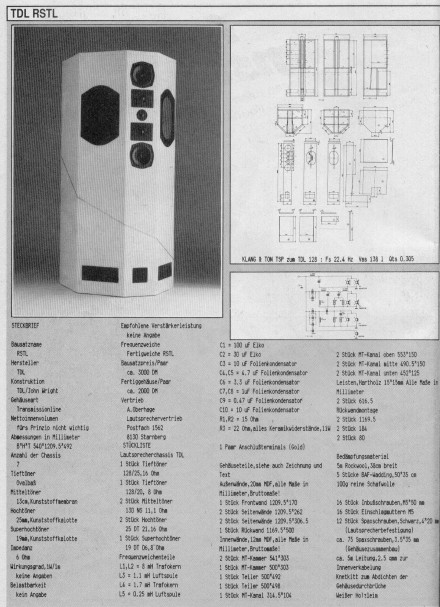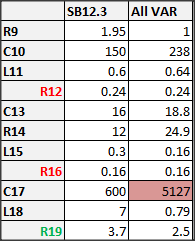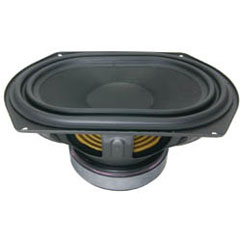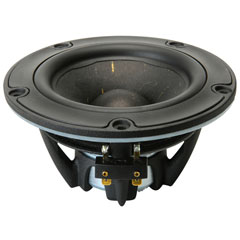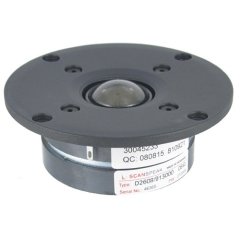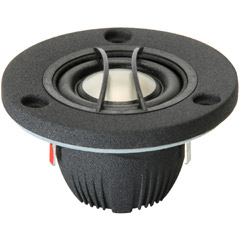Until now I’ve ignored one of the biggest cabinet problems – the Tang Band woofers are much deeper than TDL/Elac drivers used in the RSTL. How much deeper? Deep enough that I have to cut holes in the vertical dividers between the woofer and midrange sections to allow the woofer magnets room. Of course the woofer and midrange sections should not be open to one another, so I’ll need to build some sort of “cup” to cover over the hole from the midrange side. I didn’t design the hole size via a CAD system, but rather determined it empirically by cutting, trying to seat the woofer and repeat until it fit. I’m confident now I can make it work, but it certainly doesn’t appear in the original plans!
General
I’m famous!
I hadn’t been on this site for some time and just happened to check my stats the other day. I had the biggest peak ever! A little poking around and I found this post on diyAudio.com . Somebody out there actually thought this site was worthwhile. Yippee!
The Holy Grail found?
Through DIY Audio member Duck-Twacy’s generosity and zelfbouwaudio.nl member Sark’s vision, I finally have a copy of the Klang+Ton article on the DIY version of the RSTL from the December 1987/January 1988 issue. That was the first thing I learned – this article was in a single issue. I’d just assumed Klang+Ton was a monthly and it was a two-part article. Way back in 2003 Duck-Twacy posted on the DIY Audio forum that he had the article and was willing to scan for interested parties. This sounded promising, but this post was over 9 years old. Would he still be reachable on DIY Audio? Would he still have this now 24+-year-old magazine?
The answer to the first question is yes, Duck-Twacy still is reachable via the DIY Audio site some 9 years later. Amazingly, he responded overnight to my request for the scan! Did he actually still have the magazine? It didn’t sound like it, but his colleague Sark on the zelfbouwaudio.nl forum had the foresight and vision to scan all of his Klang+Ton issues, presumably just for circumstances like this. They made the entire issue available to me.
Gentlemen, thank you both. I’ve been searching for this article for a long time, so I can’t tell you how much I appreciate you making it available to me!
Finished DIY kit pictures
The same thread I referenced in my post also contained pictures of a finished kit. Very minimalist. Very modern. I love the white finish. HIFISENTRALEN member 2-mas clearly did a beautiful job on them.
Klang + Ton RSTL DIY Project
The original RSTL design was published as a kit in the December 1987 and January 1988 issues of the German DIY audio magazine Klang + Ton. I’ve searched all over for the entire article, but so far I’ve only found a link to a photo of one page from this topic on a forum for classic KEF speakers:
http://www.hifiloudspeakers.info/speakertalk/viewtopic.php?p=6854
I’ve copied the picture below to make sure this priceless heirloom isn’t lost. I’ll remove it at the request of the original owner. As you can see though it really isn’t clear enough to make out much of the required information, though after pouring over it for some time, I have gleaned a great deal of information from it:
My German is not what it used to be – actually I don’t know German at all – so I sat down with Google Translate and came up with this translation of the text:
Fact Sheet
RSTL
ManufacturerTDL
ConstructionTDL/John Wright
Enclosure TypeTransmission Line
Net Internal VolumeNot important for TL
Dimensions in mmWxHxD 540x1209x492
Number of Drivers7
WooferOvalbaß (oval)
Midrange13cm, plastic cone
Tweeter25 mm, Plastic dome
Super tweeter19 mm, Plastic dome
Impedance6 Ω
Efficiency, 1W/1mNot available
(Power) RatingNot specified
Recommended amplifier powerNot specified
CrossoverFinished crossover RSTL
Kit price/pairAbout 3000 DM
SalesA. Oberage
Lautsprechervertrieb
Postfach 1562
8130 Starnberg
Bill of Materials
Loudspeaker Drivers TDL- 1 woofer 128/25, 16 Ohm
- 1 woofer 128/20, 8 Ohm
- 2 mids 130 NS, 11.1 Ohm
- 2 tweeters 25 DT, 16 Ohm
- 1 super tweeter 19 DT 06, 8 Ohm
- L1, L2 = 8 mH Iron core
- L3 = 1.1 mH Air core
- L4 = 1.7 mH Iron core
- L5 = 0.25 mH Iron core
- C1 = 100 μF Electrolytic
- C2 = 30 μF Electrolytic
- C3 = 10 μF Film
- C4, C5 = 4.7 μF Film
- C6 = 3.3 μF Film
- C7, C8 = 1 μF Film
- C9 = 0.47 μF Film
- C10 = 10 μF Film
- R1, R2 = 15 Ω
- R3 = 22 Ω, ceramic, 11W
Cabinet Parts
refer to drawing and text
Exterior walls, 20mm MDF, all dimensions in mm, gross
- 1 front wall 1209.5×170
- 2 side walls 1209.5×262
- 2 side walls 1209.5×306.5
- 1 back wall 1169.5×500
- 2 MT-Chamber 541×303
- 1 MT-Chamber 500×303
- 1 Divider 500×492
- 1 Divider 500×498
- 1 MT-Channel 314.5×104
- 2 MT-Channel above 553×150
- 2 MT-Channel center 490.5×150
- 2 MT-Channel below 452×125
- 2 616.5
- 2 1169.5
- 2 184
- 2 80
- 5m Rockwool 38cm wide
- 5 BAF-Wadding, 50×35 cm
- 100g pure lamb’s wool
- 16 Allen screws, M5x50mm
- 16 T-nuts, M5
- 12 Screws, black, 4x20mm
- 75 Screws, 3.5x35mm
- 5m wire, 2.5mm², for wiring
- Putty to seal the enclosure openings
- 1 pr gold binding posts
Standing on the shoulders of a giant
In trying to work out an imaginary crossover, I decided the best way to start was to take a similar design and see what CALSOD might do to optimize it. The closest design I could find to my plan (I keep changing my thoughts on drivers) is the Zaph Audio SB12.3. In particular it uses two SB Acoustics SB15NRXC30-8 5″ mid-woofers in an MTM arrangement along with a woofer. Pretty similar to the RSTLM (well, as close as anything gets these days). So I started by attempting to match the SB12.3 mid-woofer modeled response by using the crossover John Krutke specified. I then let CALSOD optimize it and it came pretty darn close to hitting the target:
Oops
It is very interesting to see what CALSOD does to the component values. Very large or very small values are often a hint to remove a component altogether or change the topology. But if you let CALSOD optimize all parameters, it can come up with some pretty crazy values. Here’s the comparison of the original SB12.3 values to the CALSOD values:
In this case, it chose a value of over 5000 μF for C17. Ouch. In this case you must mark one or more values FIXED in the optimization so CALSOD won’t try to vary this value. This will likelybe a less optimal solution, but there is not much to be done unless we want to have the huge C17 value.
Also, after the optimizer finishes its magic, we must go back and select actual values that are available to purchase. Of course you can wind (or unwind) your own inductors, parallel resistors and capacitors and so on, but you have to decide just how important it is to have exactly the right value. When I completed this exercise, the final response was:
This is clearly more ragged at 300 Hz and 1.4 kHz than the original optimized design. It requires tweaking to get just the right tuning, but to a first approximation this is a reasonable approach.
I’m not going to bore everyone with a blow-by-blow analysis of each driver tuning and each change I make along the way. Remember all I’m looking for is proof of concept for my driver choices that I could create a passive crossover with acceptable impedance if I should choose. So this doesn’t have to be perfect – just reasonable.
Thank you
I’d like to thank John Krutke at Zaph Audio and Madisound for creating and sharing this design. Frankly I don’t expect the RSTLM to ever come close to it in pure sonic terms. I’ve learned a great deal from reading the write-up for it. It is a shining example of what makes this such a great hobby.
Stereophile Obituary for John Wright
As you may know, John Wright was the mastermind behind TDL and the designer of the Master Reference. In doing some research tonight I ran across his obituary in Stereophile:
http://www.stereophile.com/news/10468/index.html
He sounds like someone I’d enjoy meeting.
Cabinet exterior design (rough draft)
This is a rough draft of the exterior design for the cabinet. The details aren’t there and some things may change. What it did tell me though is that this speaker can’t be built with a single 4’x8′ sheet of MDF, so I’m looking at 3 sheets for a pair of speakers. Ouch. Well, at least there will be room for error.
- A: Sides of speaker (outside) x2
- B: Sides of speaker (inside) x2
- C: Diagonal fronts (woofers) x2
- D: Front x1
- E: Back x1
- F, G: Inside baffles, not shown
- H: Top, bottom (inside) x2
- I: Top, bottom (outside) x2
My current thinking on drivers
I’ve spent a long time thinking about what drivers would be suitable build my TDL RSTL M. While it changes frequently, here is my current thinking as of Feb 2012.
Overview
A real challenge has been finding high impedance drivers. We live in a 4 ohm world. That is fine when you use a single driver per speaker, but the RSTL uses dual woofers, mids and tweeters. Wiring in series is an option, but that comes at a high price in efficiency. A nominal 2 ohm load seems too bruising to me, especially since the crossover is likely to make it even lower at certain frequencies. For the woofers I had no choice, but for the others I went with 8 ohm drivers.
I also agonized over insisting on metal mids and tweeters to match the “M” version of the RSTL. That is what the “M” stands for – metal. So far I’ve come to the conclusion I’m going to use the best drivers I can find for the application, regardless of material. I think that is what Wright would do. He used metal drivers for the mids and tweeters because those were the best available to him at the time. If there were something better, he would have used them.
Woofer
There is only one approximately 300 mm x 210 mm format woofer I could find – the Tang Band W8Q-1071F. There are several problems with this woofer – first it is not being imported to the US anymore. In fact, I only have three currently. Does anyone have one they’d like to sell me? Perhaps it is not even being made? Second, it is a 4 ohm woofer. I’m not sure yet if I’ll wire it in series or decide the amp will need to drive a 2(?) ohm load. We’ll just have to see.
A brilliant design move on the part of Wright was to use two different woofers. While they looked identical from the outside, one was a 16 ohm driver, the other 8 ohm. That allowed them to work in different ranges while not adding complexity to the crossover. It is not clear yet if or how I might achieve a similar result with the Tang Band.
Another BIG problem I’m facing is the depth of the W8Q. The originals were about 110 mm deep; the W8Q is a whopping 279. I’ll clearly need to rearrange the internal baffling to make room for the extra depth.
Other drivers considered
- NOS originals if I could find them
Midrange
The midrange I’m really struggling with at the moment. I keep going back and forth, up and down. Because of the narrowness of the front section of the cabinet, I’m pretty much limited to 5″ drivers (the original calls for a 13 cm driver – almost 5-1/8″ external diameter for us Yanks). The cutout diameter needs to stay under 4″. The new Vifa NE range blows everything else out of the water at the price, at least on paper. The NE123W-08 is the right size and 8 ohms.
Other drivers considered
- Dayton RS125-8 (cheap, metal and low distortion)
- Peerless – several 4″ models
- SB Acoustics (where did the 8 ohm 4″ go?)
- Scanspeak Discovery 4.5″
- Seas L12
- Tang Band Titanium 4″ (Neo and regular)
Tweeter
As I mentioned, the TDL RSTL uses two tweeters in parallel, so I focused on 8 ohm tweeters. I thought about find high-efficiency 4 ohm tweeters in series, but that did not seem as satisfying. While the Scanspeak D2608/9130 is certainly not cheap, Zaph|Audio says, “Peerless finally creates a world class tweeter to compete with the best from Seas and Scan-Speak.” In case you were wondering why a have a quote about a Peerless tweeter in a discussion about a Scanspeak, the D2608/9130 was formerly known as the Peerless HDS 810921.
Other drivers considered
- Dayton Reference RS28A-4 (Aluminum) and RS28-F (Silk) – both 4 ohm
- SB Acoustics SB29RDC and SB25AC – 4ohm
- Seas – several models – almost all are 6 ohm
- Usher 9950-20 – my second choice?
Supertweeter
The TDL RSTL uses only a single supertweeter, so here I feel pretty comfortable (finally!) with a 4 ohm driver. The TDL RSTL is designed to be angled such that the speakers cross in front of the listener. So the job of the supertweeter is to provide excellent off-axis response. Most any top-quality, modern tweeter is sufficient on-axis, but for the supertweeter I needed something with excellent response at 30 degrees off-axis as well. That pretty much dictates a 3/4″ tweeter. After pouring over every factory response plot of a 3/4″ tweeter with a small flange (that ruled out great tweeters like the Hiquphon and Vifa XT19 ring radiator), I decided on the Vifa NE19VTC-04. Vifa has a whole series of tweeters with that frame – Silk, Aluminum, Titanium and “Deep Anodized Aluminum”. The NE19VTC-04 is made of this latter material. The supertweeter is only used from about 10K up and this was the flattest off-axis in this range.
Other options considered
- SB Acoustics SB29RDCN ring radiator
- Scanspeak Illuminator R3004 – price!
- Vifa – the other NE series 3/4″ models
Welcome to TDL DIY Guy
Hi!
For some time I’ve been dreaming of building a DIY version of what I imagine to be one of the best speakers ever made – The TDL Reference Standard ‘M’. While I’ve never heard the TDL RSTL myself, there are some who say they’ve owned 1000 speakers and of them all, the RSTL is the best. At this point I don’t have a lot of hope of finding a used pair and I’ve long enjoyed building speakers, so the answer was simple – build my own.
I have no illusions that my DIY version will approach the quality of the real thing as designed by John Wright. All I’m hoping for is to have a great time, learn a lot and have a speaker that sounds pretty darn good in its own right.


